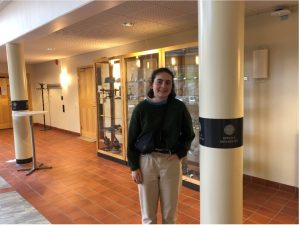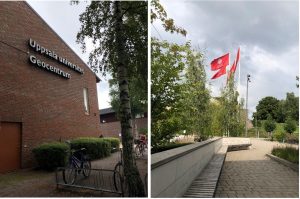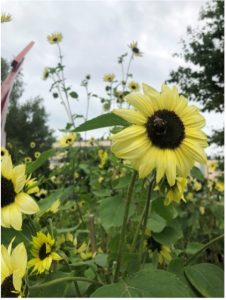The coordinating subproject (SP1) of LANDPATHS welcomed Laoise Ní Mharcaigh, third-year BSc student in Sustainability with Social Sciences, Policy and Law at University College Dublin (UCD), Ireland this summer to contribute to a review of academic literature on the barriers and opportunities for multifunctional biodiverse landscapes in Sweden.
LANDPATHS attracts student from Dublin for an internship
Laoise’s particular interests in biodiversity conservation, environmental education and citizen science and her connection to Sweden, where she has family living on Gotland, led her to discover the LANDPATHS research programme. After securing an academic scholarship from UCD’s Ad Astra Academy to cover the costs of her trip and stay in Sweden, Laoise proactively got in touch with LANDPATHS project coordinator Malgorzata (Gosia) Blicharska to explore options for a short internship within the programme.

Laoise at Geocentrum, Uppsala University
My task was to read and review a set of academic articles about various aspects of multifunctionality in Sweden’s landscapes. I started reviewing the articles in early July, picking out relevant information for the work in LANDPATHS.
Barriers and opportunities for multifunctionality reported in academic literature
Jayne Glass, a researcher in the LANDPATHS team, supported Laoise through regular advice and discussion. When Laoise came to Uppsala in early August, she continued her work in the Department of Earth Sciences, identifying the potential barriers and opportunities for multifunctionality that were evident in the papers she reviewed. She then presented and discussed her work with Gosia and Jayne, to identify recurrent themes and contribute to their plans for upcoming work on multifunctionality in LANDPATHS.
We asked Laoise what she had learned about multifunctional landscapes through her work.
Throughout my degree programme, my main focus has predominantly been situated in the realm of climate justice and environmental governance. In terms of my initial understanding of multifunctionality, I had not had much exposure other than what I had learned during a module on land-use and its environmental impact. However, coming from a rural background, I have always been aware of the ability of landscapes to provide several functions, namely the ecological, cultural and economic values of agricultural farmland. As such, I found the opportunity to delve into articles based on multifunctionality in the Swedish landscape to be hugely insightful. Most notably, the importance of forests as multifunctional landscapes and the range of roles that they play in Sweden was particularly interesting, as it is something that is not as prominent in the Irish landscape.
Potential for more public involvement in Swedish landscape policy-making?
Several of the articles Laoise reviewed referred to the importance of engaging stakeholders and citizens in decision-making about multifunctional landscapes. This raised questions in Laoise’s mind about the extent to which the public can influence land use decisions and policy in Sweden. This resonates well with the co-creation approach to stakeholder and citizen engagement in the LANDPATHS research.
Reviewing the articles has been hugely beneficial for me in that I was also able to get a strong insight into Swedish policy surrounding land-use and multi-actor governance. Following the recent nationally-led Citizen’s Assembly on Biodiversity Loss in Ireland, it was interesting to note a lack of public involvement in Swedish landscape policy-making. A Swedish Citizen’s Assembly Model could perhaps be looked at in the future.

Picture credit: Laoise Ní Mharcaigh
Literature synthesis on multifunctionality in Sweden
Laoise’s work will contribute to the ongoing research by the LANDPATHS team into the barriers to multifunctionality and the potential opportunities that exist for the future in the different landscapes that they are working in – forest, agricultural, urban, marine and coast, and mountain landscapes. In the coming months, Gosia and Jayne will be working with others in the team on an academic paper about multifunctionality in Sweden. The work Laoise did over the summer will be used in this article and we hope to remain in contact with Laoise as the paper develops. Laoise plans to bring the insights she gained about sustainable land-use from the Swedish perspective into the remainder of her degree at UCD.

Picture credit: Laoise Ní Mharcaigh
Experiencing Sweden and Uppsala
This internship, created by Laoise’s own initiative and hosted by LANDPATHS, has also been a great opportunity for Laoise to discover Sweden. She describes her experience working at a Swedish university and discussing with researchers and students as insightful and she is hoping to undertake an Erasmus exchange with Lund University in January 2024.
My recent trip to Sweden and in particular to Uppsala University has been amazing. Having only been to Gotland on previous trips, I was unsure of what to expect. However, travelling by myself to Uppsala, I felt very safe in my surroundings. It was very encouraging to visit a city where bike travel seemed to be the way to go, something that I can definitely take back with me to Ireland. I loved the feeling of walking around the city, with lots of green spaces and mature trees at every turn. My experience with visiting the University has been more than I could have asked for – I felt very welcome during my stay. Everyone that I met was very friendly and interested in hearing about my experience in Uppsala – all I can say is how I look forward to coming back!
We are delighted to have met Laoise and we are grateful for her hard work and helpful contributions to the LANDPATHS programme. We wish her all the best with her studies and hope to see her in Uppsala again soon!
